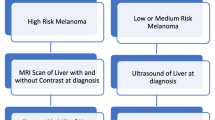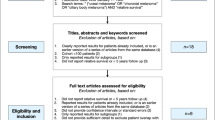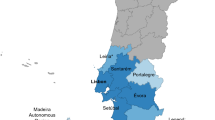Learning Objectives
Upon completion of this activity, participants will be able to:
-
1.
Describe recorded cause of death and long-term melanoma-specific survival of patients with UM, according to an analysis of SOOS data
-
2.
Determine long-term cancer-specific and all-cause survival of patients with UM, according to an analysis of SOOS data
-
3.
Identify clinical implications of long-term all-cause and cause-specific survival of patients with UM, according to an analysis of SOOS data
Continuing Medical Education
In support of improving patient care, this activity has been planned and implemented by Medscape, LLC and Springer Nature. Medscape, LLC is jointly accredited by the Accreditation Council for Continuing Medical Education (ACCME), the Accreditation Council for Pharmacy Education (ACPE), and the American Nurses Credentialing Center (ANCC), to provide continuing education for the healthcare team.
Medscape, LLC designates this Journal-based CME activity for a maximum of 1.0 AMA PRA Category 1 Credit(s)™. Physicians should claim only the credit commensurate with the extent of their participation in the activity.
Credit Hours
1.0
Release date: 25 October 2019
Expiration date: 25 October 2020
Post-test link: https://medscape.org/eye/posttest918527 
Authors/Editors disclosure information
S.S. has disclosed the following relevant financial relationships: Served as an advisor or consultant for: Allergan, Inc.; Bayer AG; Boehringer Ingelheim Pharmaceuticals, Inc.; Heidelberg Pharma GmbH; Optos; Roche. Served as a speaker or a member of a speakers bureau for: Allergan, Inc.; Bayer AG; Novartis Pharmaceuticals Corporation; Optos. Received grants for clinical research from: Allergan, Inc.; Bayer AG; Boehringer Ingelheim Pharmaceuticals, Inc.; Novartis Pharmaceuticals Corporation; Optos. A.J., L.B., M.S., V.C., P.C., and E.K. have disclosed no relevant financial relationships.
Journal CME author disclosure information
Laurie Barclay has disclosed no relevant financial relationships.
Abstract
Background/Objectives
The Scottish Ocular Oncology Service (SOOS) manages all patients with uveal melanoma (UM) in Scotland. Our aim was to determine the long-term all-cause and cause-specific survival of patients with UM, irrespective of treatment modality.
Subjects/Methods
A retrospective single-centre cohort study including all patients diagnosed with UM by the SOOS between 1/1/1998 and 31/12/2002. Data from the SOOS database were correlated with death records held by National Records of Scotland, which provided date, and all listed causes, of death for all deceased patients.
Results
Two hundred and eighteen patients were newly diagnosed with UM between 1/1/1998 and 31/12/2002. One hundred and fifteen (52.8%) were female. The mean (median) age at diagnosis was 63(65) years (range: 16–89). Of 179 choroidal melanomas, melanoma-specific survival was 92.3%, 87.4% and 83.8% at 5, 10 and 15 years, respectively. Cancer-specific survival was 85.8%, 71.8% and 62.3%. All-cause survival was 81.6% (146/179), 62.0% (111/179) and 46.7% (computed, fraction inexpressible). Of 26 ciliary body melanomas, melanoma-specific survival was 87.2%, 81.3% and 81.3% at 5, 10 and 15 years. Cancer-specific survival was 62.9%, 40.6% and 40.6%. All-cause survival was 61.5% (16/26), 38.5% (10/26) and 26.9% (7/26). Of 13 iris melanomas, at all three timepoints (5/10/15 years), melanoma-specific survival was 100%, cancer-specific survival was 92.3%, and all-cause survival was 76.9% (10/13).
Conclusions
Correlation of SOOS and national records survival data confirms 15-year melanoma-specific survival of 83.8%, 81.3% and 100% for choroidal, ciliary body and iris melanomas, respectively. We can now provide accurate survival data to our patients in Scotland.
Similar content being viewed by others
Log in or create a free account to read this content
Gain free access to this article, as well as selected content from this journal and more on nature.com
or
References
Singh AD, Bergman L, Seregard S. Uveal melanoma: epidemiologic aspects. Ophthalmol Clin North Am. 2005;18:75–84.
Shields CL, Kaliki S, Cohen MN, Shields PW, Furuta M, Shields JA. Prognosis of uveal melanoma based on race in 8100 patients: the 2015 Doyne Lecture. Eye. 2015;29:1027–35.
McLaughlin CC, Wu XC, Jemal A, Martin HJ, Roche LM, Chen VW. Incidence of noncutaneous melanomas in the U.S. Cancer. 2005;103:1000–7.
Frenkel S, Hendler K, Pe’er J. Uveal melanoma in Israel in the last two decades: characterization, treatment and prognosis. Isr Med Assoc J. 2009;11:280–5.
Singh AD, Turell ME, Topham AK. Uveal melanoma: trends in incidence, treatment, and survival. Ophthalmology. 2011;118:1881–5.
Virgili G, Gatta G, Ciccolallo L, Capocaccia R, Biggeri A, Crocetti E. et al. EUROCARE working group, survival in patients with uveal melanoma in Europe. Arch Ophthalmol. 2008;126:1413–8.
Kujala E, Mäkitie T, Kivelä T. Very long-term prognosis of patients with malignant uveal melanoma. Invest Ophthalmol Vis Sci. 2003;44:4651–9.
Kaliki S, Shields CL, Shields JA. Uveal melanoma: estimating prognosis. Indian J Ophthalmol. 2015;63:93–102.
The Collaborative Ocular Melanoma Study Group. Development of metastatic disease after enrolment in the COMS trials for treatment of choroidal melanoma. COMS report no. 26. Arch Ophthalmol. 2005;123:1639–43.
McLean IW, Foster WD, Zimmerman LE. Uveal melanoma: location, size, cell type, and enucleation as risk factors in metastasis. Hum Pathol. 1982;13:123–32.
Seregard S, Kock E. Prognostic indicators following enucleation for posterior uveal melanoma. A multivariate analysis of long-term survival with minimized loss to follow-up. Acta Ophthalmol Scand. 1995;73:340–4.
Seddon JM, Albert DM, Lavin PT, Robinson N. A prognostic factor study of disease-free interval and survival following enucleation for uveal melanoma. Arch Ophthalmol. 1983;101:1894–9.
Jovanovic P, Mihajlovic M, Djordjevic-Jocic J, Vlajkovic S, Cekic S, Stefanovic V. Ocular melanoma: an overview of the current status. Int J Clin Exp Pathol. 2013;6:1230–44.
Damato B. Does ocular treatment of uveal melanoma influence survival? Br J Cancer. 2010;103:285–90.
Singh AD, Topham A. Survival rates with uveal melanoma in the United States: 1973–1997. Ophthalmology. 2003;110:962–5.
The Collaborative Ocular Melanoma Study Group. The Collaborative Ocular Melanoma Study (COMS) randomized trial of pre-enucleation radiation of large choroidal melanoma IV: ten-year mortality findings and prognostic factors. COMS report no. 24. Am J Ophthalmol. 2004;138:936–51.
Shields CL, Furuta M, Thangappan A. Metastasis of uveal melanoma millimeter-by-millimeter in 8033 consecutive eyes. Arch Ophthalmol. 2009;127:989–98.
Shields CL, Kaliki S, Furuta M, Mashayekhi A, Shields JA. Clinical spectrum and prognosis of uveal melanoma based on age at presentation in 8,033 cases. Retina. 2012;32:1363–72.
Edge SB, Byrd DR, Compton CC (eds). AJCC Cancer Staging Manual, 7th edn. Springer: New York, NY; 2010.
Kujala E, Damato B, Coupland SE, Desjardins L, Bechrakis NE, Grange JD. et al. Staging of ciliary body and choroidal melanomas based on anatomic extent. J Clin Oncol. 2013;31:2825–31.
National Records of Scotland, Edinburgh, UK. http://www.nrscotland.gov.uk/. Accessed 15 Apr 18.
Information Services Division Scotland, National Services Scotland, NHS Scotland, UK. http://www.isdscotland.org/. Accessed 15 Apr 18.
Scottish Government. Part I – context and developments since 2006. In: Community eyecare services review. Scotland, UK: Scottish Government. https://www.gov.scot/Publications/2017/04/7983. Accessed 30 Aug 18.
Roulson J, Benbow EW, Hasleton PS. Discrepancies between clinical and autopsy diagnosis and the value of post mortem histology; a meta-analysis and review. Histopathology. 2005;47:551–9.
Maudsley G, Williams EM. Death certification by house officers and general practitioners—practice and performance. J Public Health Med. 1993;15:192–201.
Damato B. Progress in the management of patients with uveal melanoma. The 2012 Ashton Lecture. Eye. 2012;26:1157–72.
Damato B. Legacy of the collaborative ocular melanoma study. Arch Ophthalmol. 2007;125:966–8.
Baily C, O’Neill V, Dunne M, Cunningham M, Gullo G, Kennedy S, et al. Uveal melanoma in Ireland. Ocul Oncol Pathol. 2019;5:195–204.
Acknowledgements
Jaroslaw Lang (Information Services Division, NHS National Services Scotland, Meridian Court, Glasgow, Scotland) for assistance with statistical analysis. Susan Ewan (Administrator, Scottish Ocular Oncology Service, Tennent Institute of Ophthalmology, Glasgow, UK) for continued support and management of the SOOS, including maintenance of the SOOS database, and assistance with data acquisition.
Author information
Authors and Affiliations
Corresponding author
Ethics declarations
Conflict of interest
The authors declare that they have no conflict of interest.
Additional information
Publisher’s note Springer Nature remains neutral with regard to jurisdictional claims in published maps and institutional affiliations.
Rights and permissions
About this article
Cite this article
Jamison, A., Bhatti, L.A., Sobti, M.M. et al. Uveal melanoma-associated survival in Scotland. Eye 33, 1699–1706 (2019). https://doi.org/10.1038/s41433-019-0622-9
Received:
Revised:
Accepted:
Published:
Issue date:
DOI: https://doi.org/10.1038/s41433-019-0622-9
This article is cited by
-
Additional primary malignancies in a Polish cohort of uveal melanoma patients: a review of 644 patients with long-term follow-up
BMC Ophthalmology (2023)
-
Post-enucleation outcomes of patients with uveal melanoma in Scotland
Eye (2023)
-
Clinical features and survival outcomes of ocular melanoma in a multi-ethnic Asian cohort
Scientific Reports (2020)



